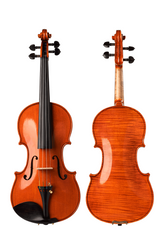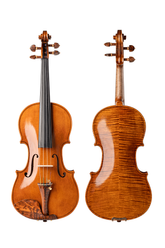How to Choose Violin Strings for Beginners - The Ultimate Guide for 2023
As a beginner, you may be unsure about how to select the right violin strings. No need to worry; this article will assist you in swiftly gaining knowledge about violin strings and provide recommendations for suitable choices.
Materials of Violin Strings
Gut Strings:
When the violin was first invented, gut strings were used, and their design hasn't changed much over the centuries.
Gut strings have lower tension compared to steel and nylon strings, and they produce a rich and complex tone, especially during overtones.
Due to their low tension and how they're strung, gut strings can be more challenging to play, and their response is slower, requiring the player to adjust the tone with the bow.
Gut strings also need frequent tuning, especially in conditions with significant temperature variations, such as when exposed to intense stage lighting.
Steel(Metal Strings):
Since the 20th century, violins began to use steel strings, and various winding techniques and materials were invented. The most common material is chrome steel.
Steel strings are known for their quick response, producing a clear, focused, and bright tone. However, don't expect to hear the depth and complexity of sound that you might get from gut strings.
Typically, classical musicians don't prefer steel strings, but they are popular in other musical genres.
Steel strings are also used on less valuable instruments, as they are the most affordable option.
Today, steel E strings come in three varieties: plain steel, plated steel, and deoxidized steel. Plain steel strings were the earliest steel strings. In recent years, many steel strings have been plated with other metals, such as tin, gold, or platinum.
Gold-plated strings produce a bright, clear, and pure tone, but they may wear out quickly as the plating wears off.
Deoxidized steel strings use steel as their core material, usually with chrome steel, offering a slightly less edgy and bright sound, and a warmer, rounder tone, albeit with a slower response. This is a good choice for those who find their steel E string too sharp or experience whistling when switching from the A string to the open E string. For the latter case, D'Addario's Kaplan Solutions E string is highly recommended.
Nylon Strings(Synthetic Core Strings):
The Austrian brand Thomastik-Infeld produces "Dominant strings," which are made from Perlon, a type of nylon. These strings have been incredibly successful, with some considering them a game-changer in the history of violin performance.
Nylon strings sound similar to gut strings but offer more stable tuning and maintain a more concentrated sound in complex overtones. In recent years, various materials have been experimented with to create a more diverse sound, often referred to as composite strings. While these strings sound less like gut strings, they offer a more interesting and nuanced tonal personality.
Comparison of Gut Strings, Metal Core Strings, and Synthetic Core Strings
Violin strings typically come in three main types: gut strings, metal core strings, and synthetic core strings, each with its characteristics advantages, and disadvantages.
Gut Strings:
- Characteristics:
- Traditional Material: Gut strings are the oldest material for violin strings, typically made from sheep intestines.
- Warm Tone: Gut strings produce a warm, rich, and emotionally expressive tone, making them highly regarded by many musicians.
- Sensitivity: These strings are incredibly sensitive and can capture subtle musical expressions.
- Advantages:
- Beautiful Sound Quality: Gut strings offer a unique sound, particularly suitable for classical and Baroque music.
- Musical Expressiveness: They allow musicians to convey their emotions and nuances.
- Disadvantages:
- Expensive: Gut strings are more expensive than other types of strings.
- Sensitivity: They are sensitive to humidity and temperature, requiring more frequent tuning and maintenance.
- Stability: They are less stable compared to other types of strings, necessitating more frequent adjustments.
Metal Core Strings:
- Characteristics:
- Modern Material: Metal core strings use a metal core, typically wound with steel wire.
- Bright Tone: These strings produce a bright, clear tone suitable for various musical styles.
- Stability: Metal core strings offer relatively stable performance under humidity and temperature variations.
- Advantages:
- Durability: Metal core strings are relatively durable and have a longer lifespan.
- Versatility: They are suitable for various musical genres, including classical, pop, and modern music.
- Disadvantages:
- Lower Musical Expressiveness: Metal core strings may have slightly lower musical expressiveness compared to gut strings.
- Potential for Harsh Noise: Unskilled playing, may produce harsh noises.
Synthetic Core Strings:
- Characteristics:
- Modern Material: Synthetic core strings use materials like nylon, composites, and others.
- Warm and Bright Tone: Synthetic core strings combine the characteristics of gut and metal strings, producing a warm yet bright tone.
- Stability: They offer better stability in humidity and temperature variations compared to gut strings.
- Advantages:
- Variety: There are multiple synthetic core string options to meet different musicians' needs.
- Durability: They are relatively durable and less affected by humidity and temperature.
- Disadvantages:
- Adaptation Needed: Some musicians may need time to adapt to the characteristics of synthetic core strings.
- Not as Expressive as Gut Strings: While highly expressive, they still fall short of traditional gut strings.
Different types of violin strings are suitable for different music styles and individual musician preferences. Choosing the right strings is crucial as they directly impact the sound quality and performance. Ultimately, musicians can select the strings that best match their needs and preferences.
String Thickness and Tension
String thickness and tension are two distinct but closely related concepts that significantly impact the sound and playability of a violin. Beginners may sometimes confuse them, but you can refer to the following concepts for a better understanding.
Thickness (Gauge):
The thickness of a string refers to the diameter or cross-sectional area of the string. It is typically measured in millimeters (mm) or inches. String thickness can be categorized into different levels, such as heavy gauge, medium gauge, and light gauge.
Heavy Gauge: Heavy gauge strings have a larger diameter. They typically require more tension to reach the standard pitch, resulting in a louder and deeper tone. They also demand more bow pressure to play, which may require stronger bowing techniques.
Light Gauge: Light gauge strings have a smaller diameter. They usually require less tension to reach standard pitch, producing a brighter tone and being easier to play. Light gauge strings may be more manageable for technically demanding pieces.
Medium Gauge: Medium gauge strings fall between heavy and light gauges, offering a balanced choice suitable for various musical styles and playing needs.
Tension:
String tension refers to the force the string experiences when played. Tension can influence the string's tone, volume, and playing feel. In general, higher tension means the string is under more force, potentially resulting in a brighter tone and greater volume. Lower tension, on the other hand, may lead to a softer tone and reduced volume.
You can refer to the image below, which is a screenshot from the Thomastik-Infeld brand's website.

Should beginners use mixed violin strings?
For beginners, the most ideal scenario is to use a complete set of violin strings right out of the box. This is the easiest approach for novice players.
When you purchase a violin, it typically comes pre-strung, and beginners need not worry about selecting and mixing different strings themselves. This can be a challenging task for beginners.
However, as you gain more experience, you can consider experimenting with different strings to suit various violins and achieve specific performance outcomes.
For beginners, a recommended option is the "Fiddlover Knight Violin Outfit Q033," which comes pre-fitted with a high-quality set of alloy strings. Additionally, this outfit includes a gift of the D'ADDARIO Prelude violin string set, making it particularly well-suited for novice players.

For intermediate players, the "Baron Intermediate Violin Outfit Q003" is an excellent choice. This violin outfit includes the Thomastik AL100 Violin Strings Set as a gift, catering to players with a more advanced skill level.

Which strings have a longer lifespan?
The lifespan of strings is not necessarily related to their price, as it depends on playing style and potential chemical reactions with an individual's body.
Factors like sweat and playing technique can influence how long your strings last. You might find yourself changing strings every few months or only once a year. Regardless, it's important to remember to loosen your strings after playing.
Additionally, string degradation occurs gradually, and the change in sound can be so subtle that you may not notice until you replace them.
Brand of Violin Strings
There are numerous brands of violin strings, but I favor the following three:
D’Addario
Thomastik-Infeld
Pirastro
Many violins at Fiddlover Violin Shop come strung with strings from these three brands, and customers have reported excellent results. Of course, there are many other string brands to choose from.





